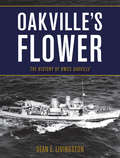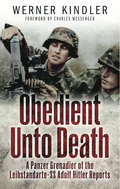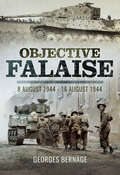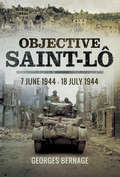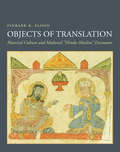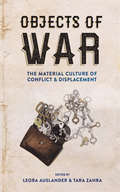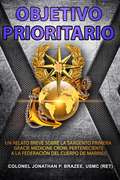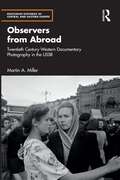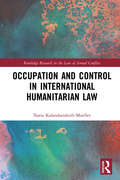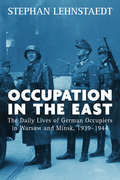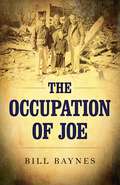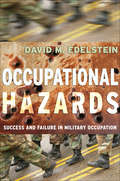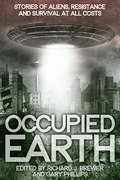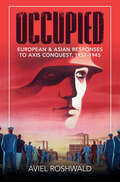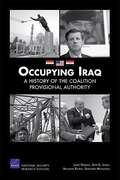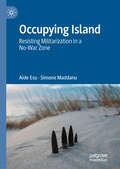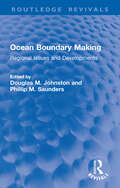- Table View
- List View
Oakville's Flower: The History of the HMCS Oakville
by Sean E. LivingstonThe story of HMCS Oakville, a corvette that fought U-boats in WWII and remains a hero to its hometown in Oakville, Ontario. This is an in-depth look at the history and legacy of HMCS Oakville, a Canadian World War II corvette that fought in the Battle of the Atlantic, and was one of the few corvettes to sink a U-boat. From its creation through its christening off the shores of its namesake town, its exploits at sea, the famous encounter with U94, and the ship’s lackluster end, Oakville’s is a story that showcases not only our nation’s proud naval heritage, but also the importance of remembrance. Oakville’s Flower sets the scene of naval war in the Atlantic — the battles between convoys, stealthy U-boats, and the lowly corvettes that formed the backbone of the Royal Canadian Navy. We follow Oakville, one of those corvettes, through its rise and fall as a Canadian naval legend, to its revival in the town of Oakville, championed by the local Sea Cadet Corps that shares its name and safeguards its legacy.
Oath Betrayed: America's Torture Doctors
by Steven H. MilesThe news that the United States tortured prisoners in the war on terror has brought shame to the nation, yet little has been written about the doctors and psychologists at these prisons. In Oath Betrayed, medical ethics expert and physician Steven H. Miles tells how doctors, psychologists, and medics cleared prisoners for interrogation, advised and monitored abuse, falsified documents--including death certificates--and were largely silent as the scandal unfolded.
Oathbreakers: The War of Brothers That Shattered an Empire and Made Medieval Europe
by David M. Perry Matthew Gabriele"This is a serious, meticulous history that will also appeal to Game of Thrones fans, who will discover intriguing parallels between history and fiction.” — Booklist"An enlightening portrait of the medieval mindset.” — Publishers WeeklyThe authors of The Bright Ages return with a real-life Game of Thrones—the story of the Carolingian Civil War, a bloody, protracted battle pitting brother against brother, father against son, that would end an empire, upend a continent, and redefine the future of Europe By the early ninth century, the Carolingian empire was at the height of its power. The Franks, led by Charlemagne, had built the largest European domain since Rome in its heyday. Though they jockeyed for power, prestige, and profit, the Frankish elites enjoyed political and cultural consensus. But just two generations later, their world was in shambles. Civil war, once an unthinkable threat, had erupted after Louis the Pious’s sons tried to overthrow him—and then placed their knives at the other’s neck. Families who had once charged into battle together now drew each other’s blood.The Carolingian Civil War would rage for years as kings fought kings, brother faced off against brother, and sons challenged fathers. Oathbreakers is the dramatic history of this brutal, turbulent time. Medieval historians David M. Perry and Matthew Gabriele illuminate what happens when a once unshakeable political and cultural order breaks down and long suppressed tensions flare into deadly violence. Drawn from rich primary sources, featuring a wide cast of characters, packed with dramatic twists and turns, this is history that rivals the greatest fictional epics—with consequences that continue to shape our own world.Oathbreakers offers lessons of what deep cracks in a once-stable social and political fabric might reveal, and the bloody consequences of disagreeing on facts and reality. The Civil War at the heart of this tale asks: who is “in” and who is “out”? And what happens when things fall apart?
Obasan
by Joy KogawaA story of the evacuation, relocation, and dispersal of Canadian citizens of Japanese ancestry during the Second World War. Based on the author's own experiences. >
Obedient Unto Death: A Panzer-Grenadier of the Leibstandarte- SS Adolf Hitler Reports
by Werner Kindler“Kindler’s detailed, often harrowing account of armored operations of the elite German Leibstandarte-SS Adolf Hitler during World War II . . . gripping.” —HistoryNet.comBetween 1941 and 1944 Waffen-SS Oberscharfhrer (Sergeant) Werner Kindler took part in 84 days of close combat, qualifying him for the Close Combat Clasp in Gold, the Third Reich’s highest decoration for a frontline soldier. He was also awarded the German Cross in Gold, the Iron Cross First and Second Class and the Wound Badge in Gold.Drafted into the SS-Totenkopf in 1939, he served with a motorized unit in Poland, and in May 1941 was selected for the Leibstandarte-SS Adolf Hitler, with which he fought in the invasion of the Soviet Union. His unit converted to a Panzer Grenadier formation in 1942, and Kindler went on to fight at Kharkov and Kursk on the Eastern Front, and later in Belgium and France in 1944. At the end of the war, he was the last man of the Leibstandarte-SS to surrender to the Americans. This is one of the most dramatic first-hand accounts to come out of the Second World War.“In addition to providing a colourful account of his experiences, Kindler also provides a very valuable insight into the social experiences and politics that brought the Nazis to power.” —Firetrench
Obeying Orders: Atrocity, Military Discipline and the Law of War
by Mark J. OsielA soldier obeys illegal orders, thinking them lawful. When should we excuse his misconduct as based in reasonable error? How can courts convincingly convict the soldier's superior officer when, after Nuremberg, criminal orders are expressed through winks and nods, hints and insinuations? Can our notions of the soldier's "due obedience," designed for the Roman legionnaire, be brought into closer harmony with current understandings of military conflict in the contemporary world? Mark J. Osiel answers these questions in light of new learning about atrocity and combat cohesion, as well as changes in warfare and the nature of military conflict. Sources of atrocity are far more varied than current law assumes, and such variations display consistent patterns. The law now generally requires that soldiers resolve all doubts about the legality of a superior's order in favor of obedience. It excuses compliance with an illegal order unless the illegality - as with flagrant atrocities - would be immediately obvious to anyone. But these criteria are often in conflict and at odds with the law's underlying principles and policies. Combat and peace operations now depend more on tactical imagination, self-discipline, and loyalty to immediate comrades than on immediate, unreflective adherence to the letter of superiors' orders, backed by threat of formal punishment. The objective of military law is to encourage deliberative judgment. This can be done, Osiel suggests, in ways that enhance the accountability of our military forces, in both peace operations and more traditional conflicts, while maintaining their effectiveness. Osiel seeks to "civilianize" military law while building on soldiers' own internal ideals of professional virtuousness. He returns to the ancient ideal of martial honor, reinterpreting it in light of new conditions, arguing that it should be implemented through realistic training in which legal counsel plays an enlarged role rather than by threat of legal prosecution. Obeying Orders thus offers a compelling answer to the question that has most haunted the moral imagination of the late twentieth century: the roots - and restraint - of mass atrocity in war.
Objective Falaise: 8 August 1944–16 August 1944
by Georges BernageOn the night of 8 August 1944, the First Canadian Army launched Operation Totalize, directing their advance towards Falaise, with the intention of breaking through the German defences south of Caen. In spite of large numbers, they were halted by the 12.SS- Panzer-Division "Hitierjugend", who managed to block the 600 armored vehicles. During one of the German counter-attacks, several Tiger tanks were destroyed, including that of panzer ace, Michael Wittmann, who was killed in the process.The offensive was relaunched a few days later under the name Operation Tractable, the intention this time being to capture the strategically important town of Falaise and close the 'Falaise Pocket', also known as the 'Corridor of Death'.This book provides the reader with a day-by-day account of this forgotten battle, while also acting as a field guide, including maps and both comtemporary and modern photographs.
Objective Saint-Lô: 7 June 1944–18 July 1944
by Georges Bernage&“A collection of eyewitness accounts of the heavy fighting that took place in this part of France after the Omaha landings . . . excellent and gripping.&”—FSAddon This book provides a day-by-day account of the forty-two days of fighting from Omaha Beach to Saint-Lô. Follow Lt. Allsup from the beaches at Hill 108 (the &“bloody hill&”), where he was injured, and Lt. Jones, who was among the first to enter Saint-Lô; a town destroyed by bombs, which was to become the graveyard of hundreds of Normans. On the opposing side, discover the fate of the fearsome &“green devil&” paratroopers of General Schimpf and follow in the footsteps of paratroopers Erwin Schmieger and Rudi Frühbeisser, as they defend their armed camp, ensuring that every hedge will only be taken at the highest price. Objective Saint-Lô takes the reader along the little or unknown routes from the horrors of Omaha Beach to Trvires, La Cambe, Isigny, through the Aure valley to Hill 108, (&“Purple Heart Hill&”) and Hills 192 and 122. As well as authentic eyewitness testimony, the book also acts as a field guide, including maps and both contemporary and modern photographs. &“Lavishly illustrated with sketch maps, then and now images and numerous personal accounts from US and German sources, this is an excellent campaign overview, ideal for tour planning.&”—Guild of Battlefield Guides &“An exciting story with insights from those who were there and an amazing collection of photographs, drawing and maps—Highly Recommended.&”—Firetrench
Objects Of Translation: Material Culture And Medieval Hindu-Muslim Encounter
by Finbarr B. FloodObjects of Translation offers a nuanced approach to the entanglements of medieval elites in the regions that today comprise Afghanistan, Pakistan, and north India. The book--which ranges in time from the early eighth to the early thirteenth centuries--challenges existing narratives that cast the period as one of enduring hostility between monolithic "Hindu" and "Muslim" cultures. These narratives of conflict have generally depended upon premodern texts for their understanding of the past. By contrast, this book considers the role of material culture and highlights how objects such as coins, dress, monuments, paintings, and sculptures mediated diverse modes of encounter during a critical but neglected period in South Asian history. The book explores modes of circulation--among them looting, gifting, and trade--through which artisans and artifacts traveled, remapping cultural boundaries usually imagined as stable and static. It analyzes the relationship between mobility and practices of cultural translation, and the role of both in the emergence of complex transcultural identities. Among the subjects discussed are the rendering of Arabic sacred texts in Sanskrit on Indian coins, the adoption of Turko-Persian dress by Buddhist rulers, the work of Indian stone masons in Afghanistan, and the incorporation of carvings from Hindu and Jain temples in early Indian mosques. Objects of Translation draws upon contemporary theories of cosmopolitanism and globalization to argue for radically new approaches to the cultural geography of premodern South Asia and the Islamic world.
Objects of War: The Material Culture of Conflict and Displacement
by Tara Zahra Leora AuslanderHistorians have become increasingly interested in material culture as both a category of analysis and as a teaching tool. And yet the profession tends to be suspicious of things; words are its stock-in-trade. What new insights can historians gain about the past by thinking about things? A central object (and consequence) of modern warfare is the radical destruction and transformation of the material world. And yet we know little about the role of material culture in the history of war and forced displacement: objects carried in flight; objects stolen on battlefields; objects expropriated, reappropriated, and remembered.Objects of War illuminates the ways in which people have used things to grapple with the social, cultural, and psychological upheavals wrought by war and forced displacement. Chapters consider theft and pillaging as strategies of conquest; soldiers' relationships with their weapons; and the use of clothing and domestic goods by prisoners of war, extermination camp inmates, freed people, and refugees to make claims and to create a kind of normalcy.While studies of migration and material culture have proliferated in recent years, as have histories of the Napoleonic, colonial, World Wars, and postcolonial wars, few have focused on the movement of people and things in times of war across two centuries. This focus, in combination with a broad temporal canvas, serves historians and others well as they seek to push beyond the written word.Contributors:Noah Benninga, Sandra H. Dudley, Bonnie Effros, Cathleen M. Giustino, Alice Goff, Gerdien Jonker, Aubrey Pomerance, Iris Rachamimov, Brandon M. Schechter, Jeffrey Wallen, and Sarah Jones Weicksel
Objetivo prioritario
by Héctor Jonathan P. BrazeeUn relato breve sobre la sargento primera Gracie Medicine Crow, perteneciente a la Federación del Cuerpo de Marines
Obras completas (Anne Frank)
by Anne FrankUna recopilación magistral que contextualiza la importancia que tuvo la escritura para la supervivencia física y espiritual de Anne Frank, y talla sus palabras en la memoria. El Diario de Anne Frank es una de las lecturas más conocidas sobre la Segunda Guerra Mundial y, gracias a él, la memoria de su protagonista sigue más vigente que nunca. Cientos de miles de personas visitan cada año el museo de la Casa de Anne Frank, en Ámsterdam, para ver dónde la niña y su familia se escondieron de las fuerzas de la ocupación alemana hasta que fueron enviados a Auschwitz en 1944. El único miembro de la familia que sobrevivió al Holocausto fue el padre de Anne, Otto Frank. Estas Obras completas reúnen diversas versiones del diario de Anne, incluida la canónica, editada por la traductora y autora Mirjam Pressler, además de material inédito como cartas, reflexiones, ensayos o las citas favoritas de su protagonista. Este volumen también contiene textos de reputados historiadores sobre asuntos como «La vida de Anne Frank», «La historia de la familia de Anne Frank» y «La historia de la recepción del diario», así como numerosas fotografías de los Frank y del resto de habitantes del escondite. Para conmemorar el 75 aniversario de la primera publicación del Diario, Plaza & Janés brinda a los lectores esta recopilación de los escritos de la joven, con el apoyo del Fondo Anne Frank, que su padre, Otto, estableció para salvaguardar el legado de su hija. Una lectura esencial tanto para los expertos como para el gran público ya que recoge, por primera vez, todos los escritos de Anne Frank además de material adicional que ofrecerá una profundidad nueva a su lectura.
Observers from Abroad: Twentieth Century Western Documentary Photography in the USSR (Routledge Histories of Central and Eastern Europe)
by Martin A. MillerObservers from Abroad offers an examination of published and archival images of Soviet Russia, providing a deeper understanding of the complexities and vicissitudes of its political culture.The book argues that photography, when accurately interpreted, can be utilized as primary historical evidence that has the potential to both enhance and counter traditional verbal analysis. Employing a number of images of the Soviet Union captured by gifted documentary photographers from the West, who received visas to work in Moscow from the Bolshevik seizure of power in 1917 to the collapse of the USSR in 1991, the book also assesses the intentions of the photographers, who acted as conscious observers capturing visual evidence under the restraining conditions of state surveillance. Each chapter provides a closer look at the life and work of these photographers, with a wealth of historical images and discussion.Richly illustrated and engaging, this volume will be ideal for students, scholars, and readers interested in Soviet history, twentieth century history, and the history of photography.
Obtaining Life-Cycle Cost-Effective Facilities in the Department of Defense
by Clifford A. Grammich Katharine Watkins Webb Constantine Samaras Abigail HaddadThe Department of Defense (DoD) constructs, operates, and maintains a large number of facilities. DoD incorporates life-cycle cost-effective practices into many aspects of the military planning and construction processes. This report provides RAND’s description and assessment of the process used to obtain life-cycle cost-effective facilities and how that affects DoD construction options and choices.
Occam's Razor
by T. R. RydenWhen ancient artifacts discovered in the Great Pyramid of Giza shed new light on a DNA pattern identified by a world-renowned molecular biologist, venture capitalist, James Anderson, is thrust into an action-packed road of scientific exploration and discovery. An unlikely participant in the events that begin to unfold, Anderson and his team, pursued by those who don’t want this new information out, realize they have stumbled upon the greatest and most terrifying cover-up in the history of the human race.Occam’s Razor is a chilling speculative fiction thriller which ties together several well-known, and some not so famous controversial theories concerning alien visitation, human evolution, ancient legends, and the cosmos. The novel explains how it could be very plausible to imagine that the powers that be may already know about an impending disaster and caught between all this are the novel’s unfortunate characters as they struggle to figure out what to do in the face of unstoppable catastrophe.
Occupation and Control in International Humanitarian Law (Routledge Research in the Law of Armed Conflict)
by Natia Kalandarishvili-MuellerThis book presents a systematic analysis of the notion of control in the law of military occupation. The work demonstrates that in present-day occupations, control as such occurs in different forms and variations. The polymorphic features of occupation can be seen in the way states establish control over territory either directly or indirectly, and in the manner in which they retain, relinquish or regain it. The question as to what level and type of control is needed to determine the existence and ending of military occupation is explored in great detail in light of various international humanitarian law instruments. The book provides an anatomy of the required tests of control in determining the existence of military occupation based on the law. It also discusses control in relation to occupation by proxy and when and how the end of control over territory occurs so that military occupation is considered terminated. The study is informed by relevant international jurisprudence. It draws on numerous pertinent case studies from all over the world, various reports by different UN entities and other international organisations, as well as legal doctrine. The book will be a valuable resource for academics, researchers and practitioners working in the fields of international humanitarian law, international public law, and security studies
Occupation in the East: The Daily Lives of German Occupiers in Warsaw and Minsk, 1939-1944
by Stephan LehnstaedtFollowing their occupation by the Third Reich, Warsaw and Minsk became home to tens of thousands of Germans. In this exhaustive study, Stephan Lehnstaedt provides a nuanced, eye-opening portrait of the lives of these men and women, who constituted a surprisingly diverse population—including everyone from SS officers to civil servants, as well as ethnically German city residents—united in its self-conception as a “master race.” Even as they acclimated to the daily routines and tedium of life in the East, many Germans engaged in acts of shocking brutality against Poles, Belarusians, and Jews, while social conditions became increasingly conducive to systematic mass murder.
Occupation of Joe
by Bill BaynesTokyo, 1945. A Japanese boy too old for his years, a survivor of the American firebombing, dares to cross the wasteland where he saw thousands burn to death, and approach the occupying forces to get food for his family. A young Navy lieutenant, proud of the Allied victory but appalled by the devastation he sees across the city, cares enough to help. As post-war pressures mount between the two cultures, he becomes entangled in the lives of the boy, his infant sister and his beautiful mother. The Occupation of Joe is an emotionally powerful, gripping post-war tragedy from Top Hat Books, publisher of quality historical fiction.
Occupation: The Ordeal of France 1940-1944
by Ian OusbyFrance was slow and somewhat ineffectual in organizing resistance movement. In Occupation Ian Ousby challenges the myth that France was liberated " by the whole of France." The author explores the Nazi occupation of France with superb detail and eyewitness accounts that range from famous figures like Simone de Beauvoir, Charles de Gaulle, Andre Gide, Jean-Paul Sartre and Gertrude Stein to ordinary citizens, forgotten heroes and traitors.
Occupational Hazards: Success and Failure in Military Occupation (Cornell Studies in Security Affairs)
by David M. EdelsteinFew would contest that the U.S. occupation of Iraq is a clear example of just how fraught a military occupation can become. In Occupational Hazards, David M. Edelstein elucidates the occasional successes of military occupations and their more frequent failures. Edelstein has identified twenty-six cases since 1815 in which an outside power seized control of a territory where the occupying party had no long-term claim on sovereignty. In a book that has implications for present-day policy, he draws evidence from such historical cases as well as from four current occupations—Bosnia, Kosovo, Afghanistan, and Iraq—where the outcome is not yet known. Occupation is difficult, in Edelstein's view, because ambitious goals require considerable time and resources, yet both the occupied population and the occupying power want occupation to end quickly and inexpensively; in drawn-out occupations, impatience grows and resources dwindle. This combination sabotages the occupying power's ability to accomplish two tasks: convince an occupied population to suppress its nationalist desires and sustain its own commitment to the occupation. Structural conditions and strategic choices play crucial roles in the success or failure of an occupation. In describing those factors, Edelstein prescribes a course of action for the future.
Occupied Earth
by Richard Brewer Gary PhillipsRESISTANCE IS ALLFor years, writers and filmmakers have speculated about the possibility of the Earth being invaded by aliens from another planet. But what if the aliens have been watching us, infiltrating us via human collaborators, or even surgically altering themselves to look human?Occupied Earth is a groundbreaking anthology that explores the idea of what the world would look like years after its conquest. 20 years after a successful invasion by the Makh-Ra, humanity still exists, only it has become subservient to a race of occupiers who govern the devastated planet. But, as much at things continue with some sense of normalcy, something has happened in the Mahk-Ra's empire. Earth, once considered a strategic beachhead of major importance to the Empire, has been downgraded in its value. Things are starting to degrade. Our planet is the last place any self-respecting Mahk-Ra officer wants to be assigned. Yet, despite everything, life continues.These stories bring us face to face with annihilation - and show how we can pull ourselves back from the brink. Featuring Rachel Howzell Hall, Lisa Morton, Matthew V. Clemens, Howard Hendrix, Nathan Walpow and more, OCCUPIED EARTH is coming. Stay safe. Stay strong. Survive at all costs.
Occupied: European and Asian Responses to Axis Conquest, 1937–1945
by Aviel RoshwaldFor most of the population of Europe and East and Southeast Asia, the most persistent and significant aspect of their experience of the Second World War was that of occupation by one or more of the Axis powers. In this ambitious and wide-ranging study, Aviel Roshwald brings us the first single-authored, comparative treatment of European and Asian responses to German and Japanese occupation during the war. He illustrates how patriotic, ethno-national, and internationalist identities were manipulated, exploited, reconstructed and reinvented as a result of the wholesale dismantling of states and redrawing of borders. Using eleven case studies from across the two continents, he examines how behavioral choices around collaboration and resistance were conditioned by existing identities or loyalties as well as by short-term cost–benefit calculations, opportunism, or coercion.
Occupying Iraq: A History of the Coalition Provisional Authority
by James Dobbins Seth G. Jones Benjamin Runkle Siddharth MohandasFocuses on the activities of the Coalition Provisional Authority during the first year of the occupation of Iraq. Based on interviews and nearly 100,000 never-before-released documents from CPA archives, the book recounts and evaluates the efforts of the United States and its coalition partners to restore public services, counter a burgeoning insurgency, and create the basis for representative government.
Occupying Island: Resisting Militarization in a No-War Zone
by Simone Maddanu Aide EsuThis book offers an analytical perspective of the unfolding militarization in the Italian island of Sardinia, grounded in extensive ethnographic fieldwork, and using in-depth documentation analysis. Since the late 1950s, the island, which is the second largest in the Mediterranean, has been one of the main hubs for weapons testing and interforce training for the Italian armed forces and NATO. The book retraces the extent and the significance of military bases in Sardinia, and the rise of local collective actions and resistance. This case study offers relevant insights to understand the strategic role of islands in the post-war military space control, more specifically on geo-strategic policy in the Mediterranean and its effects on military/civil relations. The relevance of the militarization of islands shed a light on opaque institutional decision processes that reinforce the figure of subaltern subjects - relegated to peripheral spaces and subdued to extractivism, dependency, and exclusion. It will be of interest to students and researchers of sociology, sociology of environment and risk, globalization, social movement studies, postcolonial studies and political studies.
Ocean Boundary Making: Regional Issues and Developments (Routledge Revivals)
by Douglas M. Johnston Phillip M. SaundersOriginally published in 1988, this book was written at a time when many nations were engaged in various forms of ocean boundary making. This created new regional pressures and the need for collective regional responses to these issues. This book examines the issues at stake and the boundary making processes. It discusses these in a general way, showing how the Third UN conference on the Law of the Sea helped resolve the problems whilst leaving some issues unresolved. The book goes onto examine the issues and boundary making processes in 7 important areas of the world
